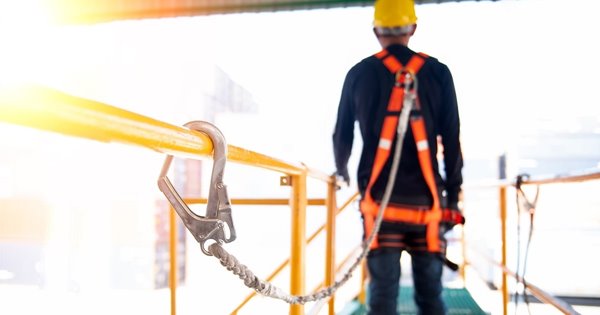Summary: Falls are the leading cause of death in the construction industry. To raise awareness and help protect workers from fall hazards at a construction worksite, OSHA developed the National Stand-Down to Prevent Falls in Construction, held May 5-9, 2025. 
The
Occupational Safety and Health Association (OSHA) and the
U. S. Department of Labor has designated May 5-9, 2025, as
National Stand-Down to Prevent Falls in Construction. This is the tenth year of the program, which encourages employers in the construction industry to raise awareness regarding
fall prevention with their employees. OSHA developed the program in conjuncture with the National Institute for Occupational Safety and Health (NIOSH), National Occupational Research Agenda (NORA), National Safety Council (NSC), National Construction Safety Executives (NCSE), The Center for Construction Research and Training (CPWR) and the U.S. Air Force to help train millions of workers on
fall prevention safety methods.
As part of the event, OSHA encourages organizations to use #StandDown4Safety on social media to share feedback after their events and obtain personalized participation certificates.
What is a Safety Stand-Down?
A
Safety Stand-Down is a voluntary worksite event where employers talk to their employees about potential job hazards and the importance of
workplace safety programs. National Stand-Down to Prevent Falls in Construction week presents an ideal opportunity for managers and staff to discuss fall hazards and fall prevention measures. OSHA encourages anyone involved in the construction industry who wants to prevent workplace hazards to participate in the Stand-Down.
How to Conduct a Safety Stand-Down
OSHA has provided
suggestions for holding a Stand-Down event, including the following:
- Determine the best time to have a stand-down at your worksite, such as first thing in the morning, during a break or at lunchtime
- Encourage subcontractors, owners, architects and project engineers to attend the stand-down event with the site workers and management team
- Review your fall prevention program, including a list of what types of falls could happen on the worksite or what training and equipment needs to be provided to protect workers from falls
- Plan an agenda for the stand-down detailing information about fall hazards, prevention methods and your company’s workplace safety programs with hands-on exercises, when possible
- Promote the stand-down by including the details in company newsletters, flyers, etc.
- Perform follow-ups to check on adjustments and improvements after a stand-down

Fall Safety Tips
Millions of people receive treatment for fall-related injuries in emergency rooms every year. Falls are the
leading cause of fatalities for construction workers, accounting for one-third of worksite deaths in the construction industry. Almost two-thirds of fatal falls were from roofs, scaffolds and ladders. Proper fall prevention strategies could help prevent these deaths.
OSHA realizes fall incidents are generally complex events that could involve many different factors. Fall protection is a strategy used to protect workers from fall hazards on worksites, including areas such as stairways, raised platforms, roofs and the
use of ladders. The protection plans must work with both the human and equipment-related issues in protecting workers from fall hazards.
Fall Protection Safety Plans
Preventing falls in the workplace often begins with having a set of written safety procedures. The plan should state the process for
fall prevention training, safe equipment use and worksite inspections. Employees and managers should be involved in the fall protection program and held accountable for following workplace safety practices such as regularly inspecting fall protection equipment and replacing worn or broken equipment. Also, the fall prevention training should be reviewed and updated as needed.
Fall Protection Safety Equipment
Employers must provide their employees with the proper equipment and fall prevention measures to avoid fall-related injuries. This might include items such as:
- Body harnesses
- Guardrail systems
- Personal fall arrest systems
- Safety net systems
- Lanyards/Lifelines
OSHA has determined that workers must be protected by guardrail systems, safety net systems, or personal fall arrest systems, even if they are not engaged in leading-edge work. The protections must be in place if they are on a walking or working surface that is 6 feet or more above a level where leading edges are under construction.

AmTrust Offers Loss Control Services
AmTrust’s
Loss Control team can provide the expert advice your construction business needs to ensure your ongoing success. From
commercial property protection and other
safety resources, we can create a customized loss control program designed specifically for your organization.
Contact us today to learn more.
This material is for informational purposes only and is not legal or business advice. Neither AmTrust Financial Services, Inc. nor any of its subsidiaries or affiliates represents or warrants that the information contained herein is appropriate or suitable for any specific business or legal purpose. Readers seeking resolution of specific questions should consult their business and/or legal advisors. Coverages may vary by location. Contact your local RSM for more information.